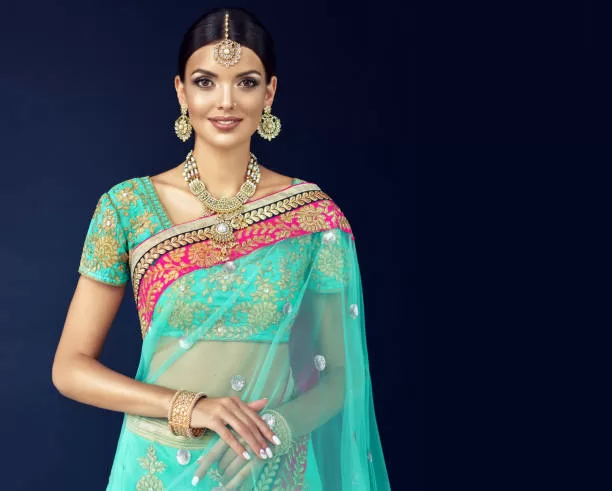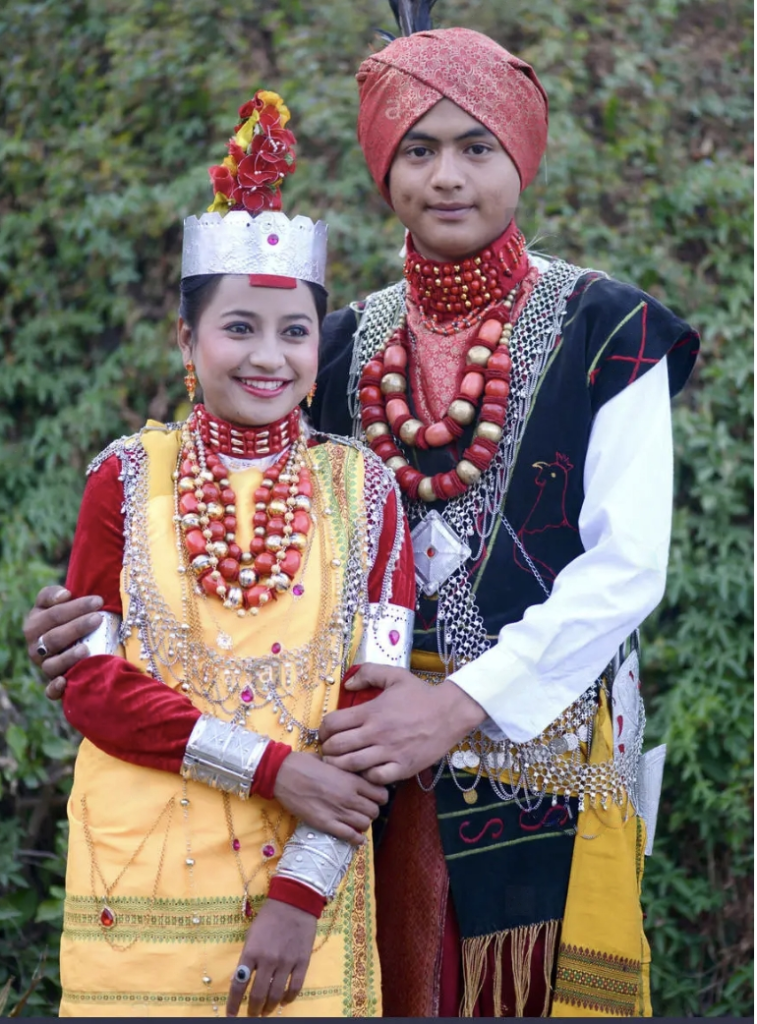India is a land of diversity, and the same can be said for its traditional attire. The traditional attire of India varies greatly depending on the region, culture, and occasion. From the vibrant and colorful sarees to the elegant and regal sherwanis, India’s traditional attire is a feast for the eyes.

women’s attire
One of the most popular traditional attire for women in India is the saree. It is a long piece of fabric, typically 5 to 9 yards long, that is draped around the body in various styles, depending on the region. The saree comes in a variety of fabrics, including cotton, silk, chiffon, and georgette, among others. The saree is often adorned with intricate embroidery, zari work, and other embellishments, making it a popular choice for weddings and other special occasions.
Another popular traditional attire for women in India is the salwar kameez. It is a two-piece outfit that consists of a long tunic called a kameez and loose-fitting pants called a salwar. The salwar kameez is comfortable to wear and is available in a range of fabrics, including cotton, silk, and chiffon. It is often worn for everyday wear and is also popular for special occasions.

Men’s Attire
For men, the traditional attire of India varies from region to region. In the northern part of India, the sherwani is a popular choice. It is a long coat that is often made of silk or brocade fabric and is typically worn over a kurta and churidar, which are fitted pants that gather at the ankle. The sherwani is often embellished with intricate embroidery and other decorations, making it a popular choice for weddings and other formal occasions.
In the southern part of India, men often wear a dhoti and kurta. The dhoti is a long piece of fabric that is wrapped around the waist and legs, while the kurta is a long shirt that reaches the knees. The dhoti and kurta are often worn for formal occasions and are made of cotton or silk fabric.
One of the most recognizable traditional attires of India is the turban. The turban is a long piece of cloth that is wrapped around the head in various styles, depending on the region. The turban is often worn by men and is a symbol of pride, honor, and respect.
Therefore when comes to the traditional attire of Indian ethnic wear, from the elegant sarees to the regal sherwanis, India’s traditional attire is a reflection of its rich heritage and traditions. Whether it’s for a wedding, a festival, or just everyday wear, traditional Indian attire is a timeless and beautiful expression of the country’s cultural identity.
The striking distinction between north Indian attire And the south Indian attire
We are aware that India is a country of diverse cultures and traditions, and this is reflected in the traditional attire worn by people across different regions across India. North Indian attire is known for its vibrant colors, intricate embroidery, and ornate designs, while South Indian attire is characterized by its simplicity, elegance, and traditional prints.
North Indian Attire:
The traditional attire of North India is dominated by colorful and elaborate sarees, salwar kameez, and lehengas. The saree is a long piece of fabric draped around the body, and it is worn with a blouse and petticoat.
North Indian sarees are typically made of silk, cotton, or chiffon, and they are often embellished with intricate embroidery, sequins, and beadwork. The salwar kameez, on the other hand, is a two-piece outfit that consists of a long tunic and loose-fitting pants.
The tunic is often embellished with zari work, mirror work, and other decorations, making it a popular choice for weddings and other special occasions. The lehenga choli, which is a skirt and blouse combination, is another popular choice for weddings and formal events. The lehenga is usually made of silk or other luxurious fabrics and is often heavily embellished with embroidery, sequins, and other decorations.
South Indian Attire:
The traditional attire of South India is characterized by its simplicity, elegance, and traditional prints. The saree is the most popular traditional attire worn by women in South India, and it is typically made of cotton or silk. South Indian sarees are known for their traditional prints, such as the kanjeevaram saree, which is made of pure silk and is adorned with intricate zari work.
The Mundum neriyathum, which is a two-piece outfit that consists of a long skirt and blouse, is another popular traditional attire worn by women in South India. It is usually made of cotton and is adorned with traditional prints and designs.
Men’s Attire:
Men’s traditional attire also differs significantly between North and South India. In North India, men usually wear the sherwani, which is a long coat that is often made of silk or brocade fabric and is worn over a kurta and churidar. The turban is also an essential part of North Indian attire and is often worn on formal occasions.
In South India, men typically wear the dhoti and kurta, which is a two-piece outfit consisting of a long shirt and a piece of cloth wrapped around the waist and legs. The dhoti is usually made of cotton, and it is available in a variety of colors and prints.
In conclusion, the traditional attire of North India and South India differs significantly in terms of color, design, and fabric. North Indian attire is known for its vibrant colors, intricate embroidery, and ornate designs, while South Indian attire is characterized by its simplicity, elegance, and traditional prints.
However, both North and South Indian attire reflects the rich cultural heritage of the country and is an essential part of Indian identity.
Lets us now delve into some of the significant traditional Indian attire state wise
Traditional attire of West Bengal

The state of West Bengal, located in the eastern region of India, has a rich cultural heritage that is reflected in its traditional attire. The traditional attire of West Bengal is colorful, elegant, and steeped in history and tradition.
Sarees:
Sarees are the most popular traditional attire for women in West Bengal. The most famous saree from the region is the Baluchari saree, which is made of silk and is known for its intricate designs and patterns. The Baluchari saree is usually adorned with mythological motifs and is characterized by its rich colors, including deep red, purple, and green.
Another popular saree from West Bengal is the Tant saree, which is made of cotton and is known for its lightness and comfort. Tant sarees are often adorned with simple designs and patterns and are available in a range of colors, including white, red, and yellow.
Men’s Attire:
For men, the traditional attire of West Bengal includes the dhoti and kurta. The dhoti is a piece of cloth that is wrapped around the waist and legs and is often made of cotton. The kurta is a long shirt that reaches the knees and is usually made of cotton or silk. The combination of the dhoti and kurta is known as the dhoti-kurta and is typically worn on special occasions and festivals.
Another popular traditional attire for men in West Bengal is the kurta-pajama. The kurta-pajama is a two-piece outfit that consists of a long tunic and loose-fitting pants. It is usually made of cotton and is adorned with simple designs and patterns.
Jewelry:
Jewelry is an essential part of traditional attire in West Bengal, and women often adorn themselves with a range of ornaments, including bangles, necklaces, earrings, and anklets. The most famous jewelry from the region is the Shakha and Pola, which are bangles made of conch shells and red coral, respectively. These bangles are usually worn by married women and are considered a symbol of marital status.
Footwear:
For women, the traditional footwear of West Bengal is the jutti, which is a type of flat shoe that is usually made of leather or silk. The jutti is often adorned with embroidery and is available in a range of colors.
In conclusion, the traditional attire of West Bengal is a reflection of the rich cultural heritage of the region. From the elegant Baluchari sarees to the comfortable dhoti-kurtas, the traditional attire of West Bengal is steeped in history and tradition. It is a beautiful and vibrant expression of the region’s cultural identity and is a source of pride for the people of West Bengal.
The traditional attire of Meghalaya

Meghalaya, located in the northeastern part of India, is known for its lush green forests, rolling hills, and unique culture. The traditional attire of Meghalaya is colorful and reflects the cultural identity of the various communities that inhabit the state.
Khasi Attire:
The Khasi tribe is the largest community in Meghalaya, and their traditional attire is characterized by a distinctive style of clothing. The Khasi men wear a long-sleeved shirt called the Jymphong, which is made of cotton and is usually adorned with intricate embroidery. The shirt is worn with a long piece of cloth called the Dhara, which is draped over the shoulder and around the waist. The Dhara is usually made of cotton or silk and is adorned with simple designs and patterns.
The Khasi women wear a traditional dress called the Jainsem, which is a long-sleeved dress that reaches the ankles. The Jainsem is made of cotton or silk and is adorned with intricate embroidery and designs. The dress is usually worn with a piece of cloth called the Dakmanda, which is draped over the shoulder and around the waist.
Garo Attire:
The Garo tribe, which is the second-largest community in Meghalaya, has a unique style of clothing that is different from the Khasi attire. The Garo men wear a long-sleeved shirt called the Sima, which is made of cotton and is usually adorned with simple designs and patterns. The shirt is worn with a piece of cloth called the Dakmanda, which is draped over the shoulder and around the waist.
The Garo women wear a traditional dress called the Dakmanda or the Chelik, which is a long-sleeved dress that reaches the ankles. The dress is usually made of cotton or silk and is adorned with intricate embroidery and designs.
Jaintia Attire:
The Jaintia tribe, which is the third-largest community in Meghalaya, has a traditional attire that is similar to the Khasi attire. The Jaintia men wear a long-sleeved shirt called the Jymphong, which is made of cotton and is usually adorned with intricate embroidery. The shirt is worn with a piece of cloth called the Dhara, which is draped over the shoulder and around the waist.
The Jaintia women wear a traditional dress called the Jainsem, which is a long-sleeved dress that reaches the ankles. The Jainsem is made of cotton or silk and is adorned with intricate embroidery and designs. The dress is usually worn with a piece of cloth called the Dakmanda, which is draped over the shoulder and around the waist.
In conclusion, the traditional attire of Meghalaya is a reflection of the diverse cultures and communities that inhabit the state. From the elegant Khasi and Jaintia attire to the unique Garo clothing, the traditional attire of Meghalaya is steeped in history and tradition. It is a beautiful and vibrant expression of the region’s cultural identity and is a source of pride for the people of Meghalaya.
The traditional attire of Mizoram
Mizoram is a state located in the northeastern part of India, and its traditional attire reflects the state’s rich cultural heritage. The traditional attire of Mizoram is colorful, vibrant, and has a unique style. Let’s take a closer look at the traditional attire of Mizoram.
Puan:
Puan is the traditional attire for women in Mizoram. It is a two-piece dress consisting of a blouse and a wraparound skirt. The skirt is made of silk or cotton, and the blouse is usually made of cotton or silk. The skirt is adorned with various designs such as stripes, checks, and floral motifs. The blouse is usually plain or has simple embroidery.
Kawrchei:
Kawrchei is a traditional shawl worn by both men and women in Mizoram. It is made of cotton or silk and is adorned with intricate designs. The shawl is draped over the shoulders and is worn as a symbol of respect and honor during formal occasions.

Puanchei:
Puanchei is a traditional attire for women, which is similar to Puan, but it is made of a different fabric. Puanchei is made of Mizo handloom, which is a unique and intricate weaving style used in Mizoram. The blouse is usually plain, but the skirt has intricate designs and patterns.
Thihna:
Thihna is a traditional attire for men in Mizoram. It is a knee-length coat made of cotton or silk. The coat is adorned with intricate designs and patterns, and it is usually worn over a shirt and a pair of trousers.
Accessories:
Accessories are an essential part of traditional attire in Mizoram. Women wear a variety of jewelry such as earrings, necklaces, and bracelets. Men wear a traditional Mizo knife called a “Kakai” as a symbol of their strength and bravery.
In conclusion, the traditional attire of Mizoram is colorful, and vibrant, and reflects the state’s rich cultural heritage. From the Puan and Puanchei worn by women to the Thihna worn by men, the traditional attire of Mizoram is unique and has a distinct style.
The intricate designs and patterns on the clothing and accessories are a testament to the skilled craftsmanship of the people of Mizoram. The traditional attire of Mizoram is a source of pride for the people of the state and is a visual representation of their cultural identity.
We have seen here in this article the rich classical Attire of India, along with the fundamental distinction between the clothing style and traditional costume of south India and north India, with a particular emphasis on some of the eastern Indian attire state-wise.
In the impending continuation of this topic, which will be referred to as -Part 2, we will examine the clothing customs of a number of the other eastern Indian states. This voyage will continue with all the vitally crucial and distinctively lively dressing elegance and beauty. keep enjoying the reads.
Disclaimer:
The author’s views are his or her own. The facts and opinions in the article have been taken from various articles and commentaries available in the online media and Eastside Writers does not take any responsibility or obligation for them.
Note: Contact our Writers at www.eastsidewriters.com for writing Blogs/Articles on any niche. We have experts in various domains from Technology to Finance and from Spirituality to Lifestyle and Entertainment.







Pingback: Exploring the Vibrant Traditional Attire of India: A Focus on the Rich Cultural Costumes of Eastern India-Part 2 - Eastside Writers